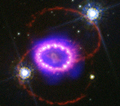Speaker
Dr
Karina Kjaer
(Queen's University Belfast)
Description
Observing the inner ejecta of a supernova is possible only in a handful of nearby
supernova remnants. SN 1987A is the first modern stellar explosion that has been
continuously observed from its beginning to the supernova remnant phase. Twenty years
after the explosion, we are now able to observe the three-dimensional spatially
resolved inner ejecta of this supernova.
We have used Integral Field Spectroscopy to image the supernova ejecta and the
equatorial ring in several infrared emission lines. The spectral information can be
mapped into a radial velocity image revealing the expansion of the ejecta both as
projected onto the sky and perpendicular to the sky plane.
The inner ejecta are spatially resolved in a North-South direction and are clearly
asymmetric. Like the ring emission, the northern parts of the ejecta are blueshifted,
while the material projected to the South of the supernova centre is moving away from
us. We argue that the bulk of the ejecta is situated in the same plane as defined by
the equatorial ring and does not form a bipolar structure as has been suggested. The
exact shape of the ejecta is modelled and we find that an elongated triaxial
ellipsoid fits the observations best.
Our observations clearly indicate a non-symmetric explosion mechanism for SN 1987A.
The elongation and velocity asymmetries point towards a large-scale spatial
non-spherical distribution as predicted in recent explosion models. The orientation
of the ejecta in the plane of the equatorial ring argues against a jet-induced
explosion through the poles due to stellar rotation.
Primary author
Dr
Karina Kjaer
(Queen's University Belfast)

